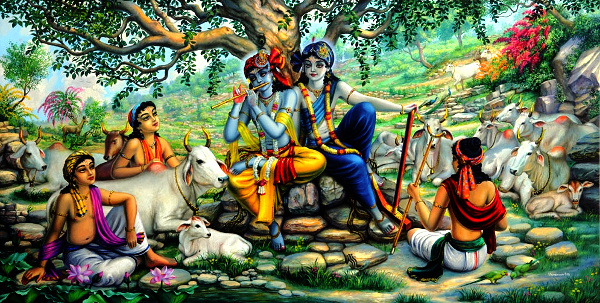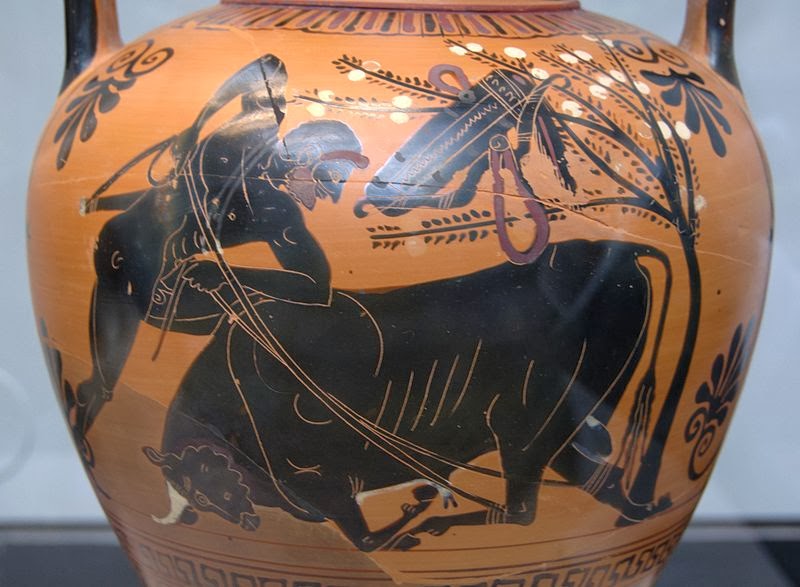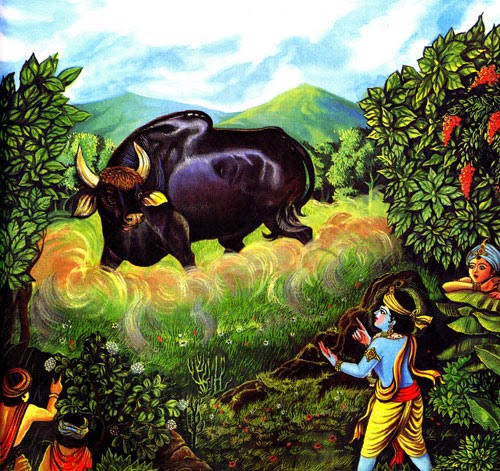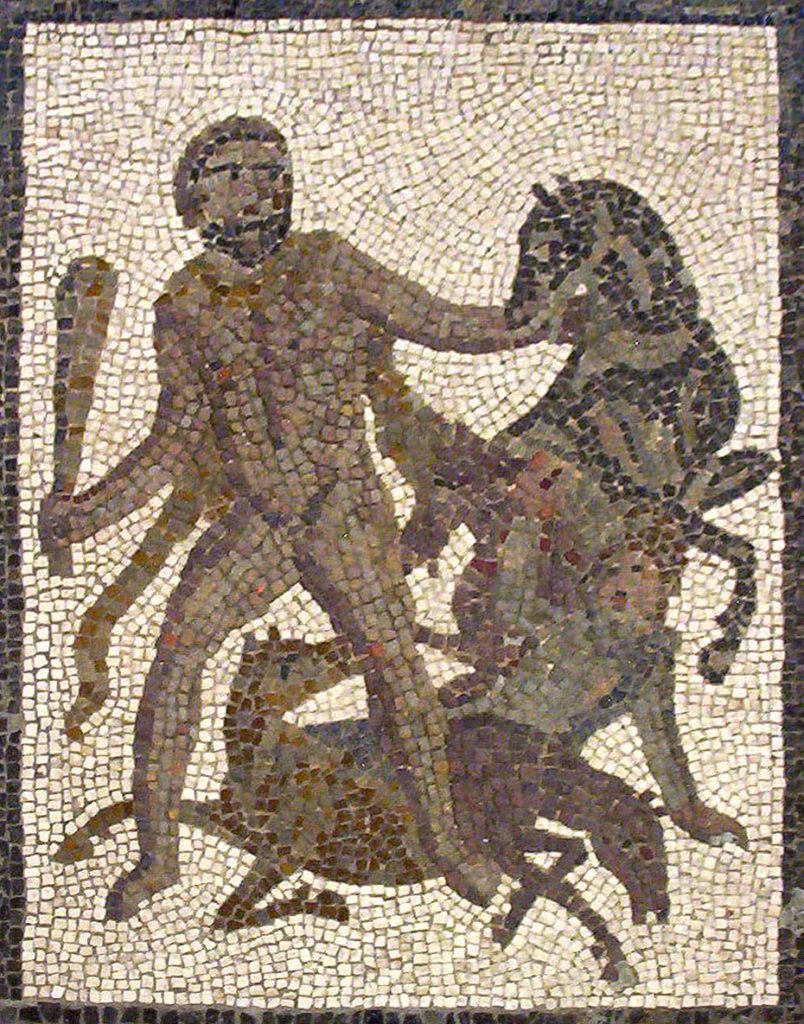Sometime around c.305 BC, the Greek geographer and explorer Megasthenes arrived at the court of the Indian emperor Chandragupta Maurya at Pataliputra (modern Patna). He was sent as an ambassador by Seleucus Nicator of the Seleucid dynasty, with whom Chandragupta Maurya had entered into a treaty and matrimonial alliance. During his stay in India, Megasthenes compiled the book Indica – a commentary on the geography, social traditions, and religious customs of India. Although, the original work of Megasthenes is no longer available, later Greek historians such as Arrian and Diodorus Siculus have referred to Indica in their works, from where we can gather snippets of some very important observations made by Megasthenes regarding the presence of Hercules in India.
The Greek Accounts of Hercules in India
Arrian (c.86 AD – 160 AD) also wrote a book called Indica, in which he drew from Megasthenes’s earlier work of the same name. Arrian says about Hercules:
“The Hercules who penetrated so far, the Indians tell us, was a native of their country. He is particularly worshiped by the Suraseni (Shurasena), who have two great cities, Methora (Mathura) and Cleisoborus (Surapura), and the navigable river Jobares (Yamuna), passes through their territories. This Hercules, as Megasthenes asserts, and the Indians themselves assure us, uses the same habit with the Theban Hercules. Many male children, but only one daughter was born to him in India, for he married many women. The daughter’s name was Pandaea, and the land where she was born, and over which Heracles placed her as ruler, was named Pandaea after her.”
Some scholars have suggested that the Hercules mentioned by Megasthenes is the Indian deity Krishna, who is widely worshipped across India. The parallels are quite remarkable, indeed. Krishna was born in Mathura, which is located on the banks of the Yamuna River, and he also belonged to the Shurasena tribe, a branch of the Yadu dynasty. However, the descriptions apply equally to Balarama, the elder brother of Krishna. Both Krishna and Balarama grew up in Mathura, on the banks of the Yamuna and they both commanded the respect and worship of their tribe.
Interestingly, while Krishna was dark-complexioned and was regarded as an avatar of Vishnu, his brother Balarama was white-complexioned, and was believed to be an incarnation of Ananta Sesha, the cosmic serpent, on whose coils Vishnu rests in the middle of the cosmic ocean. It is for this reason that the sculptures of Balarama often depict the seven hooded (or six/five hooded) snake-canopy above his head.
The Greek historian Diodorus Siculus (c.50 BC) also referred to Megasthenes’s work in his Bibliotheca historica. His description of the Indian Hercules is strongly suggestive of Balarama:
“Hercules was born amongst the Indians, and like the Greeks, they furnish him with a club and lion’s hide. In strength he excelled all men, and cleared the sea and land of monsters and wild beasts. He had many sons, but only one daughter. He built Palibothra (Pataliputra i.e. Patna) and divided his kingdom amongst his sons. ”
These are apt descriptions of Balarama, who had a towering physique and possessed extraordinary bodily strength. In the Indian tradition he is credited with inventing various techniques of wrestling and unarmed warfare. Like Hercules, Balarama is always depicted holding a club (or a mace). He was an undisputed master of fighting with the mace, and was an instructor to the royal princes.
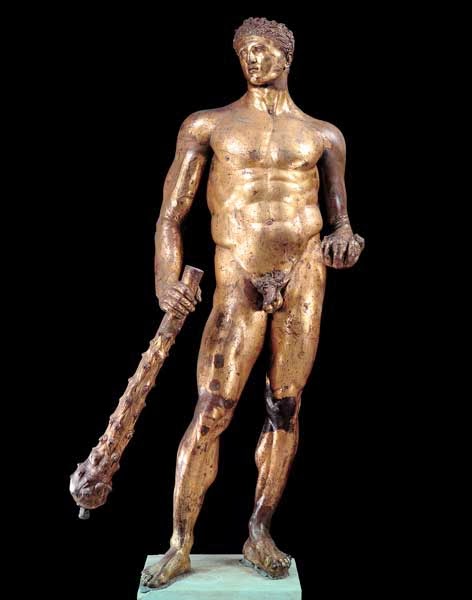
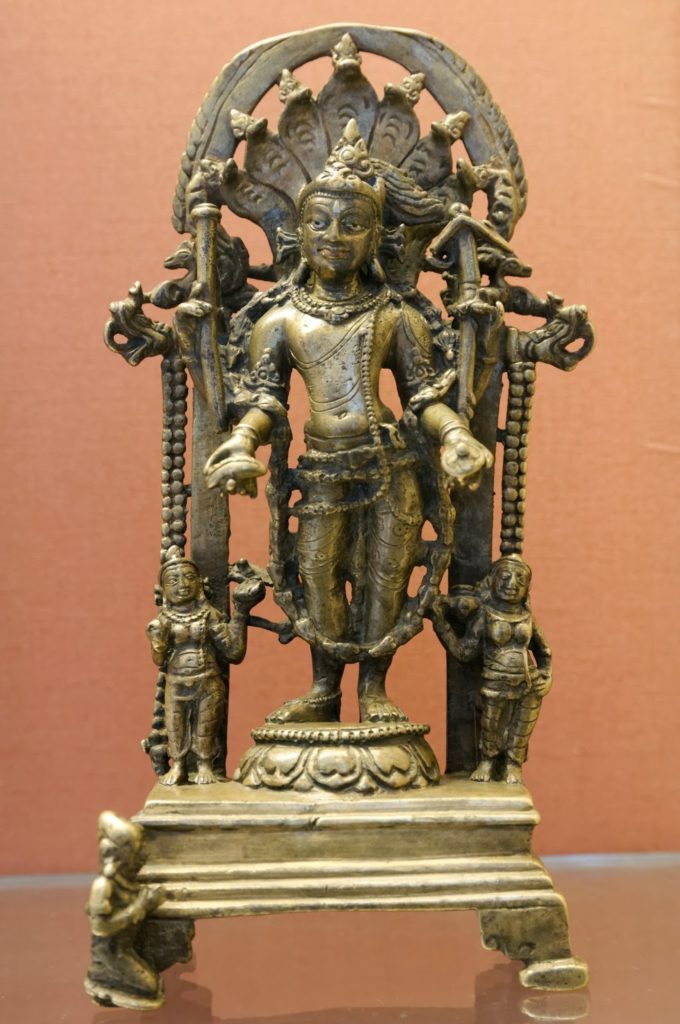
Balarama was also associated with the lion, and he was sometimes represented with the tiger’s skin or the lion’s skin draped over his shoulders.Hercules, too, used the lion’s skin as his armor; for this was the impenetrable skin of the Nemean Lion which he had killed in his first labor. In certain figures, Hercules is simply holding the lion skin in his hands or it is draped over his club. There is an interesting parallel here, with the symbolism of Balarama. In some figures, Balarama holds a lion-plough (simha-langala). In the book Iconography of Balarama, N.P.Joshi states that the lion-plough “is definitely a big winged lion with fine decorations, and a pointed tail forming the blade of a plough.” Sometimes a miniature figure of a lion is depicted on top of the plough.
The Indian accounts of Balarama do not provide specific information about the number of children he had, or how he divided up his kingdom between his sons and daughters after his death. Therefore, we cannot draw any inferences from the statements of the Greek writers, in this regard. The kingdom of Pandaea, over which the Indian Hercules is said to have placed his daughter as ruler is possibly the Pandyan kingdom of Tamil Nadu, with its capital at Madurai. The Pandyas are mentioned in the Mahabharata, where they are described as fierce warriors who took part in the Mahabharata war, and sided with the Pandavas. Since the Cholas and the Pandyas had been subjugated by Krishna, it is quite possible that Balarama may have installed his daughter as the ruler of the Pandyan kingdom.
Oriental Scholars connect Hercules and Balarama
Interestingly, the Roman philosopher Cicero (106 BC-43BC) had mentioned that, “the Indian Hercules is denominated Belus”, and he used the term Hercules Belus to refer to him. Captain Francis Wilford wrote in the Asiatic Researches (1799) that this Belus was none other than Balarama, the brother of Krishna:
“The Indian Hercules, according to Cicero, was called Belus. He is the same with Bala, the brother of Crishna, and both are conjointly worshipped at Mutra; Indeed, they are considered as one Avatara or incarnation of Vishnu. Bala is represented as a stout man, with a club in his hand. He is also called Bala-Roma… As Bala sprung from Vishnu, or Heri, he is certainly Heri-cula, Heri-culus, and Hercules. Diodorus Siculus says that the posterity of Hercules reigned for many centuries in Palibothra (Patna), but that they did nothing worthy of being recorded.”
Subsequently, Colonel James Tod, an officer of the British East India Company in India and an Oriental scholar, also made some important observations on the association between Hercules and Balarama. James Tod had worked in India for nearly 24 years, and on his return to Britain he wrote a book titled Annals and Antiquities of Rajasthan (1829), in which he states:
“How invaluable such remnants of ancient race of Harikula! How refreshing to the mind yet to discover, amidst the ruins on the Yamuna, Hercules (Baldeva, god of strength) retaining his club and lion’s hide, standing on his pedestal at Baldeo, and yet worshipped by Suraseni! This was the name (Baldeo) given to a large tract of country round Mathura, or rather round Surpura, the ancient capital founded by Surasena, the grandfather of the Indian brother-deities, Krishna and Baldeva, Apollo and Hercules. The title would apply to either; though Baldeva has the attributes of ‘god of strength’. Both are lords (es) of the race (kula) of Hari (Hari-kula-es), of which the Greeks might have made the compound Hercules. Might not a colony after the Great War have migrated westward?”
Colonel Tod’s account indicates that, as late as the 19th century, Balarama was depicted as Hercules, with a club and lion’s hide at Mathura. Colonel Tod’s suggestion that the term “Hercules” may be composed of the terms Hari-kula-es is also very illuminating. If this hypothesis is correct, then one can be quite certain that this term applied to Balarama. As the elder brother, the lordship over the Vrishni-Andhaka federation was vested in Balarama.
Colonel Tod also made an interesting observation regarding the Sobii tribe of Punjab, which Arrian had mentioned in his accounts. Arrian had said that, one of the tribes of Punjab called Sobii or Sibians, wore the skins of wild beasts, were armed with clubs like Hercules, and marked their oxen with the impress of the club. They also carried the effigies of Hercules on their banners. According to Megasthenes, the Sobii were a colony left there by Hercules. On this point, Tod had pointed out that, “this club-bearing nation is not yet extinct, and that the Chobi votaries who yet fill the temples of Heri and Baldeva in Surasena are the very people.”
These observations suggest that the Indian Hercules was none other than Balarama. If we delve into a little more detail, and compare some of the other iconographical features of Hercules and Balarama, we will be left with very little doubt regarding the veracity of this association.
The Iconographical Details
The most prominent attribute of Balarama, apart from the club, is the plough. Balarama is nearly always depicted holding the plough, which he used for warfare as well as for agriculture. As mentioned earlier, Balarama often carried the lion-plough, which is essentially a decorated, winged lion, in the form of a plough.
Interestingly, the Grecian Hercules was also associated with the plough. The Romanian author Nicolae Densusianu tells us that even in Romanian legends Hercules was a great hero, proud and magnificent, with arms like a mace, who criss-crossed the globe and defeated all the monsters of the world. A popular name of Hercules in Romanian legends is “Iorgovan”, a name which corresponds to the Greek form Georgos, meaning “the one who ploughs”. On an Imperial medallion issued by the Roman emperor Commodus, the emperor is shown dressed as Hercules, ploughing out the “original furrow” of Rome (in order to establish a sacred area for the foundation of the city) with two oxen. In one hand he holds the mace, and in the other he is guiding the plough.
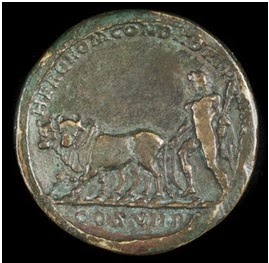
Balarama, too, was depicted similarly on bronze coins issued by the Indo-Greek ruler Agathocles (c.180-165 BC), which were discovered at the site of Ai-Khanum, along the border of the Soviet Union with Afghanistan. These coins, bearing legends in the Greek and Brahmi scripts, show Vasudeva-Krishna on one side, carrying a chakra and a conch. The other side depicts a two handed Balarama, carrying a club in his right hand and a plough in his left. Both brothers are dressed as warriors, wearing ornate headdress and earrings, and have sheathed swords hanging from their belts.
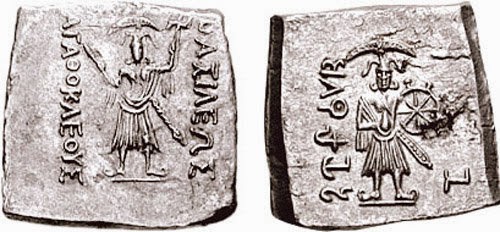
There is a well-known story associated with Balarama which highlights his dexterity in using the plough, as well as his propensity to drink wine. Once, in state of intoxication, he asked the Yamuna river to come to him so that he could bathe in it. When the river refused, he cut a channel through the river, thereby diverting the waters in his direction. It is said that Balarama had built a number of water channels in the Yamuna river. Undoubtedly, he dug these channels for agricultural purposes, because of which he came to be regarded as a god of fertility.
The same ability was also invested in Hercules. In the fifth labour of Hercules he was asked to clean the Augean stables in a single day. Hercules used his plough to dig a channel from the river Alpheus which flowed nearby. He dammed up the old channel and allowed the river to flow through the new channel. The waters rushed through the stables, washing away all the filth in a single day.
The other important attribute of Hercules was the “wine cup”. He is often depicted holding the wine cup in his hand. Balarama, too, is known for being excessively fond of drinking. N.P.Joshi tells us that, “in iconography, he is usually seen carrying a cup of wine. His wife Revati is sometimes seen accompanying him with a wine jar.”In Jainism, Balarama is known as Baladeva, and one his attributes is the drinking cup or the honey pot.
Some of the other implements which Hercules carried were the bow and arrow, as well as the sword, both of which he used in some of his labors. Not surprisingly, sculptures of Balarama also depict him with the sword, and the bow and arrow. In the Jain tradition, the attributes of Baladeva include the arrow, shield and sword. Even temperamentally Balarama and Hercules were similar; both of them had a passionate, fiery nature, accompanied by a great affection for their friends, and a desire to rid the world of evil.
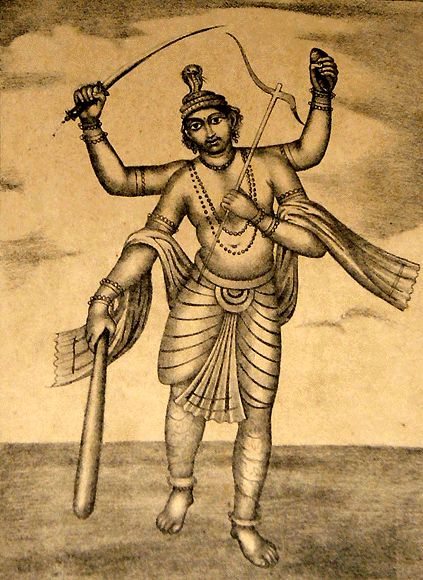
Balarama with four hands, holding the club, plough, conch and sword, with a serpent coiled on his head. Illustration by Sourindo Mohun Tagore, 1880. Source: Wikimedia Commons. 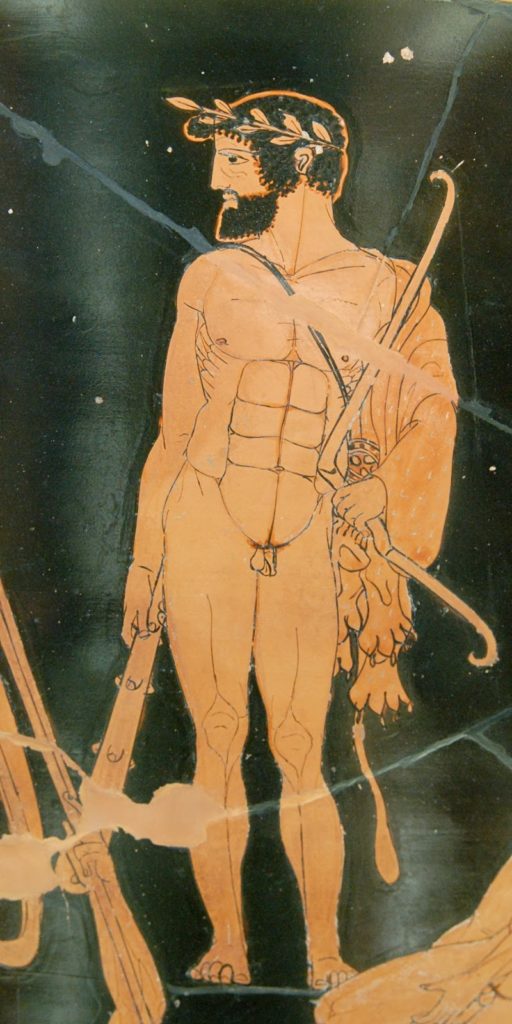
Herakles crowned with a laurel wreath, wearing the lion-skin and holding a club and a bow, c. 460–450 BC. Source: Wikimedia Commons / Marie-Lan Nguyen
It is worthwhile to note in this context that Hercules or Balarama was also popular in Iran during the time of the Seleucids (330-150 BC), with whom the Mauryan emperors of India had entered into a treaty. The Greeks rulers of the Seleucid dynasty regarded the Zoroastrian deity Bahram as Heracles. A life-size rock sculpture of Bahram on the main highway at Behistun shows him reclining with a goblet in his hand, a club at his feet and a lion-skin beneath him. Even in the early Sassanid Period (224 AD – 651 AD), Bahram appears in the relief of Ardeshir I at Naqs-e Rajab III, with a lion’s skin in his left hand and a club in his right.
These iconographical elements tell us that Bahram and Balarama were identical, and they were both regarded as Hercules by the Greeks. Like Balarama, Bahram was considered as the “giver of victory” and the “smiter of resistance”. In the Bahram Yasht, Bahram is described as “the most highly armed” (Yasht 14.1), the “best equipped with might” (14.13), with “effervescent glory” (14.3), who has “conquering superiority” (14.64), and is in constant battle with men and daemons (14.4, 14.62). He is also connected with sexual potency and “confers virility” (Yasht 14.29), has the “ability to heal” (14.3). All of these adjectives apply equally to Balarama.
Surprisingly, scholars have not yet identified this connection between Balarama and Bahram, and have instead compared Bahram to the Vedic Indra. The comparison with Indra, of course, does not make sense since Indra was an immortal and the “king of the gods”, while Hercules, and therefore Bahram, was a mortal, and who had been raised to the status of the gods after his death.
Although Hercules was indeed Balarama, he appears to have inherited many of the heroic exploits of Krishna as well, possibly because the brother deities Krishna-Balarama were conjointly worshipped at Mathura. As a result, we can detect many symbolic similarities between the exploits of Krishna-Balarama, and the labors of Hercules.
The Exploits of Hercules and Krishna-Balarama
As per the legends, Hercules had roamed the entire world, and performed many heroic acts. The brother deities Krishna-Balarama are also credited with numerous acts of heroism, and Balarama, in particular, was known for his fondness for travel. Even when the Mahabharata battle was raging, Balarama had opted out of the battle, and instead embarked on a year-long pilgrimage, during which time he is known to have killed many demons. It is possible that different cultures have preserved different versions of his exploits, and also added to them over time, in an attempt to further glorify their hero. In addition, migrations of people, as well as trade and cultural contacts over the past several thousand years must have played a role in giving shape to the currently available versions of these stories in different lands.
Therefore, when we compare the exploits of Hercules and Krishna-Balarama, we should not expect to find an exact correspondence between these accounts; what we will find, instead, are certain “symbolic elements” which appear in both the accounts, which indicate that they sprang from a common source, and pertain to the same personality.
Let us begin from the childhood of the respective heroes. When Hercules was just eight months old, his stepmother Hera had sent two poisonous snakes into his chamber. The infant Hercules, already strong and quick-witted, strangled the snakes, and played with the dead snakes. In the Indian version, the evil king Kamsa had sent the demon women Putana to kill Krishna. Putana assumed the form of a beautiful woman, smeared her breasts with poison, and tried to suckle the baby Krishna. But Krishna bit her so hard, that she fell down dead, and Krishna was found playing on her dead body.
In the second of his twelve labors, Hercules had killed the Hydra of Lerna. It was a giant, serpent-like, water monster with multiple heads, and its breath was so poisonous that Hercules covered his mouth with a cloth to protect himself. Hercules decapitated the heads of the serpent with his sword, while his nephew Lolaus used a firebrand to scorch the neck stumps after each decapitation, so that a new head would not spring up in its place. In the Indian account, a multi-hooded snake called Kaliya entered the blue waters of the Yamuna, and its poisonous fumes killed the birds, plants and trees of the region. Krishna jumped on the hoods of the serpent, smashing its heads, until the severely wounded serpent agreed to return back to the ocean.
There is an alternate version of this popular story, in which Balarama is credited with the killing of the serpent. A wall relief from Candi Vishnu, Indonesia, shows Balarama prying apart the jaws of Kaliya, while Krishna dances in triumph. This compares very favorably with the depiction of Hercules killing the Lernaean Hydra, assisted by his nephew Lolaus.
killing of the serpent Kaliya. A wall relief from Candi Vishnu, Indonesia, shows Balarama killing the serpent by splitting open his mouth, with Krisha dancing in triump. – See more at: http://bibhudev.blogspot.in/2014/03/hercules-and-balarama-symbolic-and.html#sthash.59bimy3A.dpuf
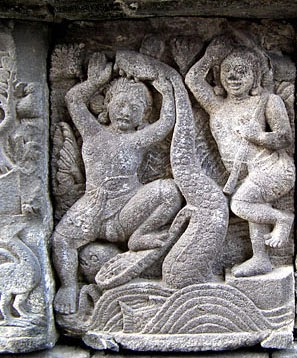
Balarama prying apart the jaws of Kaliya, while Krishna dances in triumph. Candi Vishnu, Indonesia 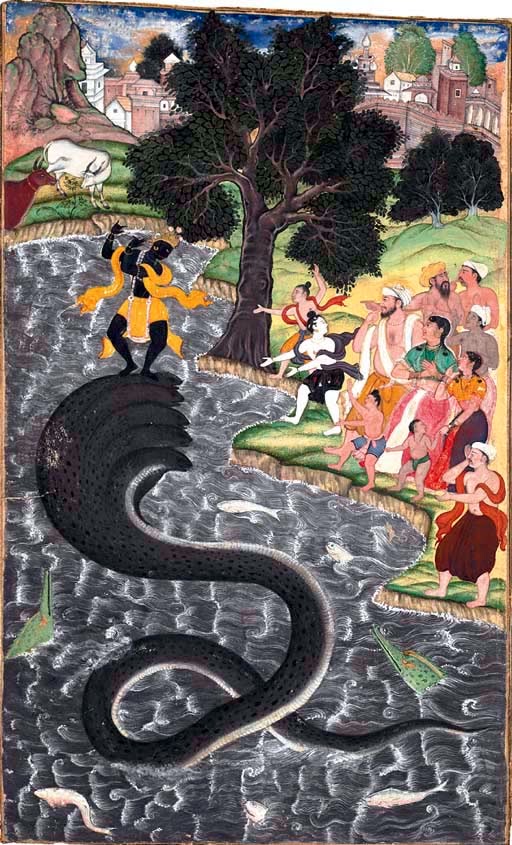
Krishna dancing on thehead of Kaliya, Imperial Mughal School, India, c.1590-1595. Source: Wikimedia Commons 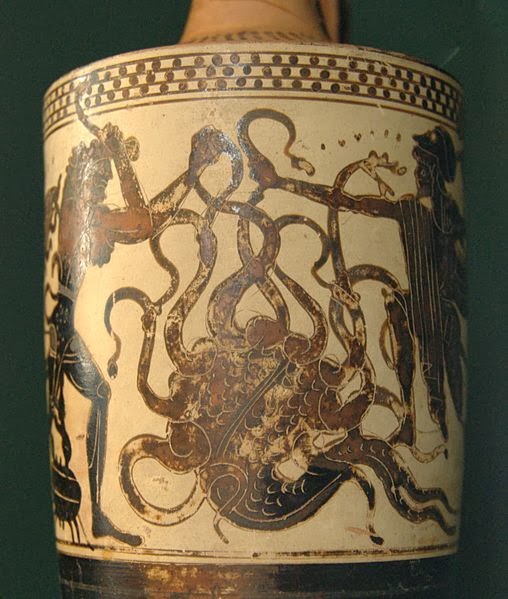
Hercules, Iolaus and the Lernaean Hydra. Attic lekythos, c. 500–475 BC. Source: Wikimedia Commons
In his sixth labor, Hercules had to kill the Stymphalian birds. These man-eating birds had beaks of bronze, and sharp metallic feathers, and Hercules killed them with his poison-dipped arrows. Krishna, too, killed a gigantic, man-eating crane with a sharp beak called Bakasura, which tried to devour Krishna. Krishna killed the monster bird by tearing apart its beaks.
In his seventh labor, Hercules captured the Cretan bull, which was wreaking havoc on Crete by uprooting the crops and leveling the orchard walls. Hercules wrestled the bull to the ground, bound it with ropes and drove it back to King Eurystheus. In the Indian version, a demon called Arishta took the form of a monstrous bull which struck terror into the hearts of the people with its wild bellows. It dredged lumps of earth from the mountain side, uprooted trees, and charged towards Vrindavan. Krishna tossed the animal to the ground, pulled out one of its horns and killed it with a few strokes of it.
The eighth labor of Hercules required him to steal the Mares of Diomedes. The four, man-eating horses were wild and uncontrollable, and breathed fire. Hercules killed Diomedes and fed him to the horses, which calmed them down. Then he bound their mouths shut, and took them back to King Eurystheus. Krishna too was attacked by a demon called Kesi, who took the form of a mighty and fast horse, whose mouth breathed fire. Krishna simply thrust his left hand into the horse’s mouth, suffocating the horse until it fell down writhing, and died.
There is a separate incident involving Balarama, in which he had entered a palm grove along with Krishna and the other boys. There he was attacked by a ferocious, flesh-eating, ass-demon called Dhenukasura. Balarama caught hold of the two hind legs of Dhenukasura, whirled him round, and dashed him against the trees. Krishna and Balarama then effortlessly killed the rest of the ass-demons, who were the companions of Dhenukasura. This incident probably bears a greater resemblance to the act of Hercules capturing the Mares of Diomedes.
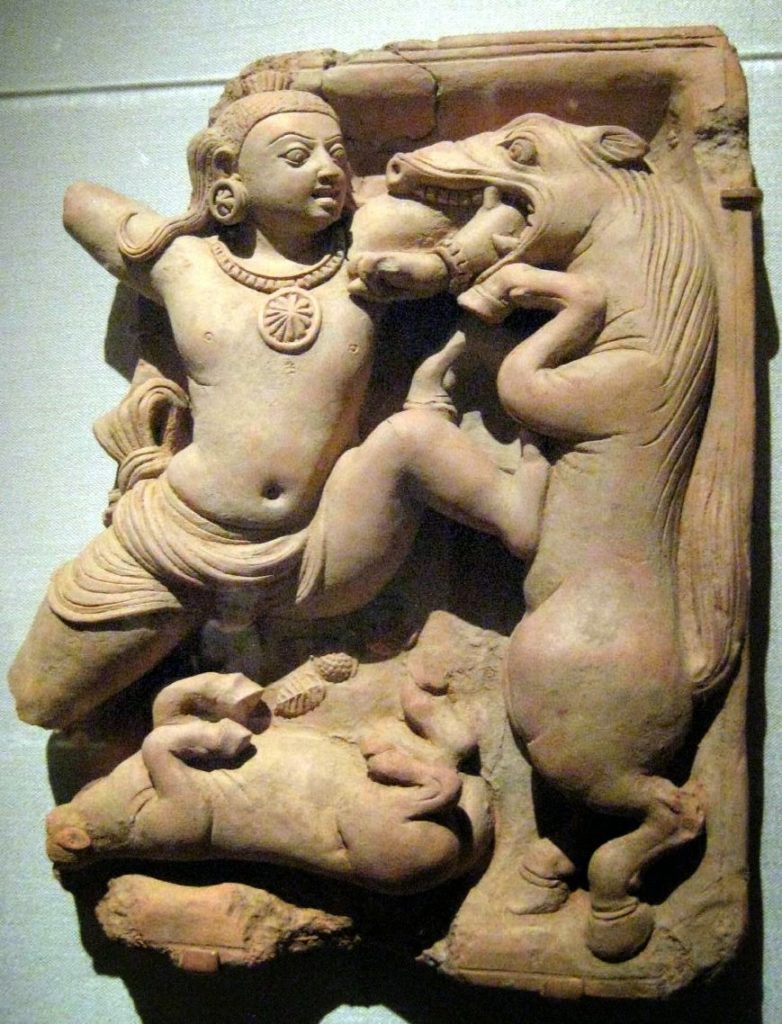
There are a couple of other exploits of Hercules, which are not included within his twelve labors, but which have their counterparts in the Indian legends. The fable of the earth-born giant Antaeus, whom Hercules killed by holding him up in the air and squeezing the breath out of his body appears to be the exact counterpart of the story in which the infant Krishna was being carried through the air by a demon called Trinavarta who was sent by Kamsa on a mission to kill the child. Krishna caught the demon’s neck tightly, and choked him to death in mid air.
In another story, the flocks of Hercules were stolen by a robber called Cacus, who hid them in cave in Mount Aventine in Italy. The theft was discovered by the sounds made by some of the oxen in the cavern. A similar event took place in Krishna’s life when the herds and cow-boys of Nanda’s farm were stolen by a robber, who hid them in a cave in a mountain quite inaccessible. However, the theft was detected when the milch-cows, which were grazing close to the cavern, heard the sound of the calves and started oozing out milk from their udders.
The similarities in these stories clearly suggest a common origin; and given the fact that Krishna-Balarama form an integral part of the epic Mahabharata, one must conclude that these stories travelled to Greece from India and not the other way round. Nor should it surprise anyone that an Eastern demigod, epitomizing strength, courage, righteousness, and the will to succeed, was adopted by the Greeks as their cultural hero. The Greeks habitually adopted foreign deities as their own. As pointed out by Sir William Jones, the Grecian Dionysus is none other than the Indian monarch Rama. According to Arrian, the Indian “Dionysus was earlier than Heracles by fifteen generations.” This statement agrees quite closely with the genealogical records of the Puranas, according to which there are 25 generations between Rama and Krishna-Balarama.
In fact, the transmission of the legend of Hercules from the countries of the East to Greece, was a well-accepted viewpoint in the early 19th century. In A Classical Dictionary (1872), Charles Anthon points to the “Oriental origin of the fable of Hercules, and its passage from the East into the countries of the West. And it will be seen that the Greeks, in conformity with their national character, appropriated to themselves, and gave a human form to, an Oriental deity; and that, metamorphosing the stranger-god into a Grecian hero, they took delight in making him an ideal type of that heroic courage and might which triumphs over every obstacle.”[xii]
The Historical Context
During the Mahabharata epoch (around 4000 BC, if we use the Saptarshi Calendar as the basis of the Yuga Cycle or around 3000 BC using the traditional date of the Kali Yuga), Greek colonies existed in close proximity to India, and many Greek kings also established small kingdoms within India.
The Mahabharata (and other Sanskrit texts) referred to the Greeks as “Yavanas”, while in the Pali language they were called “Yonas”. It is an accepted fact that these terms referred to the “Ionian Greeks” of coastal Turkey, who had colonies elsewhere in Asia during the Mahabharata epoch. As per the Mahabharata, the Yavanas were present beyond Gandhara in northwestern India, and there was a country called Parama Yona, in the far west of Yavana, which possibly referred to Ionia.
The epic mentions that the Yavanas were fierce warriors and they had participated in the Mahabharata War, along with other powerful conglomerates such as the Sakas (Scythians), Pahlavas, Hunas etc. The Yavanas also had small kingdoms within India. The Mahabharata mentions a Yavana stronghold near Mathura (the birthplace of Krishna-Balarama), and a Yavana port-city in southern India, amongst many others.
Many passages of the epic describe the warriors of the Mahabharata epoch such as Arjuna, Nakula, Sahadeva, Karna and Krishna fighting with the Yavana kings of India, in order to bring them under subjection. The Mahabharata also mentions the Yavana warrior-king called Bhagadatta, the heroic ruler of Pragjyotisha (in Assam), who had taken the side of the Pandavas during the war. What happened to these Greek colonies in India – whether they migrated westwards after the war, or they got absorbed within the Indian populace, or a combination of both – is a question that remains unanswered.
Given that many Greek colonies existed within India (and specifically at Mathura), and they had also participated in the Mahabharata War, it seems quite appropriate that the Greek glorified the brother deities Krishna-Balarama. The Greeks, and many other western peoples, who valued physical strength and heroic courage, idolized Balarama in particular, and turned him into their cultural hero; while the Indians, with their penchant for mystical wisdom, grace and beauty, and supernatural powers, became captivated by Krishna, who personified these qualities. As a result, the heroic accomplishments of the brother deities were attributed primarily to Krishna in the Indian subcontinent, while in Greece, these acts of valour and munificence were attributed to Hercules. The worship of Balarama, however, persisted in India till the modern times, particularly in the region around Mathura, which was the birthplace of Krishna-Balarama and a sacred place of worship for many thousands of years.
Author: Bibhu Dev Misra
Image Courtesy:VrindavanToday
You may also like
-
India Can’t Afford to Remain Stagnant at this Juncture, Says PM Modi; Asks People to Buy Locally-Made Goods
-
Stolen Artefacts to be Returned to India from Scotland Museums
-
Legendary Singer Lata Mangeshkar Passes Away At the Age of 92
-
Netaji’s Hologram Statue at India Gate
-
10th Century Stone Idol of Goat Head Yogini IllegallyRemoved from A Temple in Lokhari, Banda, UP Being Returned to India
